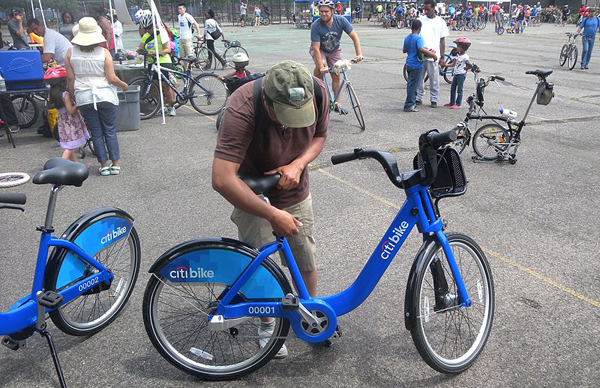
Photo by: Jim Henderson
The CitiBike has already exceeded expectations for ridership, thanks in part to a first round that target areas rich in bike riders. Should phase two aim for nearby neighborhoods, or look elsewhere in order to diversify the pool of participants?
The officials who administer New York’s Citibike program are looking to expand into several Brooklyn neighborhoods soon with 1,000 new bikes and 90 new stations, with plans for even more down the line.
Most of the early data officials released at a panel at Baruch College on Tuesday night underscored just how successful the program has been relative to early projections. Citibike was hoping to attract 60,000 members in its first year. Already it has attracted 80,000 in just its first three months. Citibike has outperformed other cities with similar but more established programs, like London, in one of their key measures: The program records about six rides per bicycle per day.
But one new piece of data shows the limitations of the program: Riders are mostly white, male, and live in households with six-figure incomes, according to Justin Ginsburg, Project Director NYC Bikeshare, which owns and runs Citibike and is itself owned by Alta Bicycle Share, which runs similar programs in Boston, London, Washington DC and others. “This is great if you’re a marketing person,” said Ginsburg, referring to the high income of riders.
With that data in mind, Charles Komanoff, the moderator of the panel, said the program needs to expand more than just geographically. “Now that it’s been proven successful, they need to commit themselves to reaching out to communities that aren’t as affluent,” said Komanoff.
Right now, the bikes are only located below 60th street in Manhattan and in a few neighborhoods in west Brooklyn.
Ginsburg said the program needed to start there because that’s where large numbers of riders were. And now the plan is to start adding connecting neighborhoods. “It has to expand in an organic way. You can’t really skip whole neighborhoods,” said Ginsburg. He attributes Citibike’s success, in part due to the high density of its bike locations compared to other cities.
This means that the relatively high density of lower-income neighborhoods in the Bronx and Queens will make them eventual targets for expansion, said Ginsburg. But the next phase is slated for neighborhoods in Brooklyn that are contiguous with areas that already have the Citibike program, he said.
Compared to the monthly cost of the subway, Citibike represents a great value for low-income residents, said Ginsburg: the annual fee of $95 breaks out to less than $10 a month, compared to more than $100 a month for the subway.
But Komanoff said inequities still need to be addressed. “At the end of the day, $95 for people at the margin is money that they don’t have to begin with,” said Komanoff.
The make-up of the three-member panel at Baruch last night underscored the unique collaboration on the Citibike program: a private management company, supported by the city’s Department of Transportation, and funded in part by a large financial institution. This collaboration made it possible to start and run the program without any taxpayer dollars.
It also means that the goals of the program are divided: make money for Alta Bicycle Share, promote Citibank’s image and meet the transportation needs of a diverse city. Ginsburg said that his company’s decision-making process about where to expand next took into account multiple factors. “If it was just a purely dollars and cents decision, we would be going to the Upper West Side next,” said Ginsburg.








One thought on “What's the Next Stop for CitiBike?”
Pingback: Citibikes are for Rich People